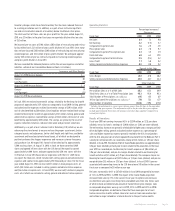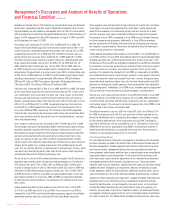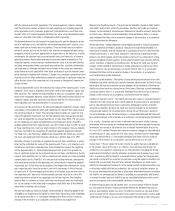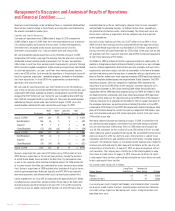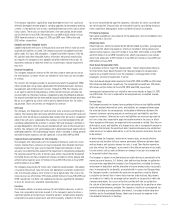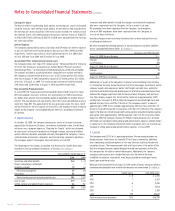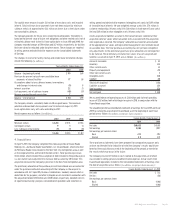Walgreens 2010 Annual Report Download - page 24
Download and view the complete annual report
Please find page 24 of the 2010 Walgreens annual report below. You can navigate through the pages in the report by either clicking on the pages listed below, or by using the keyword search tool below to find specific information within the annual report.
Based on current knowledge, we do not believe there is a reasonable likelihood that
there will be a material change in the estimates or assumptions used to determine
the amounts recorded for income taxes.
Liquidity and Capital Resources
Cash and cash equivalents were $1,880 million at August 31, 2010, compared to
$2,087 million at August 31, 2009. Short-term investment objectives are to minimize
risk, maintain liquidity and maximize after-tax yields. To attain these objectives,
investment limits are placed on the amount, type and issuer of securities.
Investments are principally in U.S. Treasury market funds and Treasury Bills.
Net cash provided by operating activities was $3,744 million at August 31, 2010,
compared to $4,111 million a year ago. The decrease from the prior year is primarily
attributable to lower working capital improvements. For the year, we generated
$306 million in cash flow from working capital improvements, primarily through
better accounts payable management. Higher earnings also positively contributed
to cash from operations. Last year, cash flows from working capital improve-
ments were $728 million. Cash provided by operations is the principal source of
funds for expansion, acquisitions, remodeling programs, dividends to shareholders
and share repurchases. In fiscal 2009, we supplemented cash provided by
operations with long-term debt.
Net cash used for investing activities was $1,274 million versus $2,776 million last
year. In the current year we invested $3,000 million in short-term Treasury Bills, and
redeemed $3,500 million. Additions to property and equipment were $1,014 million
compared to $1,927 million last year. During the year, we added a total of 670 loca-
tions (550 net) compared to 691 last year (562 net). There were 95 owned locations
added during the year and 65 under construction at August 31, 2010, versus 183
owned locations added and 42 under construction as of August 31, 2009.
Work- Home Specialty Mail
Drugstores sites Care Pharmacy Service Total
August 31, 2008 6,443 364 115 10 2 6,934
New/Relocated 556 36 5 5 — 602
Acquired 70 3 11 5 — 89
Closed/Replaced (72) (26) (26) (5) — (129)
August 31, 2009 6,997 377 105 15 2 7,496
New/Relocated 359 24 4 1 — 388
Acquired 281 — 1 — — 282
Closed/Replaced (75) (34) (9) (2) — (120)
August 31, 2010 7,562 367 101 14 2 8,046
Business acquisitions this year were $779 million versus $405 million in fiscal
2009. Business acquisitions in the current year primarily include the purchase
of all 258 Duane Reade stores located in the New York City metropolitan area,
as well as the corporate office and two distribution centers for $558 million net
of assumed cash of $6 million; and selected other assets (primarily prescription
files). Business acquisitions in 2009 included select locations of Drug Fair to our
retail drugstore operations; McKesson Specialty and IVPCARE to our specialty
pharmacy operations; and selected other assets (primarily prescription files).
Capital expenditures for fiscal 2011 are expected to be approximately $1.4 billion,
excluding business acquisitions and prescription file purchases. We expect new
drugstore organic growth of between 2.5% and 3.0% in fiscal 2011. During the
current fiscal year we added a total of 670 locations, of which 359 were new or
Management’s Discussion and Analysis of Results of Operations
and Financial Condition (continued)
relocated drugstores. We are continuing to relocate stores to more convenient
and profitable freestanding locations. In addition to new stores, expenditures
are planned for distribution centers and technology. The timing and size of any
new business ventures or acquisitions that we complete may also impact our
capital expenditures.
Net cash used by financing activities was $2,677 million in fiscal 2010. In fiscal
2009, net cash from financing activities provided $309 million. Upon the closing
of the Duane Reade acquisition we assumed debt of $574 million. Subsequent to
closing, we retired all Duane Reade debt for $576 million. In the prior year we had
net proceeds from the issuance of long-term debt of $987 million and repayments
of short-term borrowing of $70 million.
On October 14, 2009, our Board of Directors approved a long-term capital policy: to
maintain a strong balance sheet and financial flexibility; reinvest in our core strategies;
invest in strategic opportunities that reinforce our core strategies and meet return
requirements; and return surplus cash flow to shareholders in the form of dividends
and share repurchases over the long term. In connection with our capital policy, our
Board of Directors authorized a share repurchase program (2009 repurchase program)
and set a long-term dividend payout ratio target between 30 and 35 percent. The 2009
repurchase program, which was completed in September 2010, allowed for the
repurchase of up to $2,000 million of the Company’s common stock prior to its
expiration on December 31, 2013. Shares totaling $1,640 million were purchased in
conjunction with the 2009 repurchase program during fiscal 2010. On October 13, 2010,
our Board of Directors authorized a new share repurchase program (2011 repurchase
program) which allows for the repurchase of up to $1,000 million of the Company’s
common stock prior to its expiration on December 31, 2012. To support the needs of
the employee stock plans, we purchased shares totaling $116 million in fiscal 2010,
compared to $279 million in fiscal 2009. We had proceeds related to employee stock
plans of $233 million during the current fiscal year as compared to $138 million a year
ago. Cash dividends paid were $541 million during the current fiscal year versus
$446 million a year ago.
We had no commercial paper outstanding at August 31, 2010. In connection with
our commercial paper program, we maintain two unsecured backup syndicated
lines of credit that total $1,100 million. The first $500 million facility expires on
July 20, 2011, and allows for the issuance of up to $250 million in letters of credit,
which reduce the amount available for borrowing. The second $600 million facility
expires on August 12, 2012. Our ability to access these facilities is subject to our
compliance with the terms and conditions of the credit facility, including financial
covenants. The covenants require us to maintain certain financial ratios related to
minimum net worth and priority debt, along with limitations on the sale of assets
and purchases of investments. At August 31, 2010, we were in compliance with all
such covenants. The Company pays a facility fee to the financing banks to keep
these lines of credit active. At August 31, 2010, there were no letters of credit
issued against these facilities and we do not anticipate any future letters of credit
to be issued against these facilities.
Our current credit ratings are as follows:
Long-Term Commercial
Rating Agency Debt Rating Paper Rating Outlook
Moody’s A2 P-1 Stable
Standard & Poor’s A A-1 Stable
In assessing our credit strength, both Moody’s and Standard & Poor’s consider
our business model, capital structure, financial policies and financial statements.
Our credit ratings impact our borrowing costs, access to capital markets and
operating lease costs.
Page 22 2010 Walgreens Annual Report









